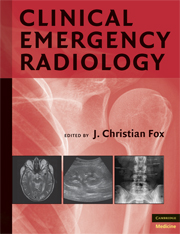Book contents
- Frontmatter
- Contents
- Contributors
- PART I PLAIN RADIOGRAPHY
- PART II ULTRASOUND
- 12 Introduction to Bedside Ultrasound
- 13 Physics of Ultrasound
- 14 Biliary Ultrasound
- 15 Trauma Ultrasound
- 16 Deep Venous Thrombosis
- 17 Cardiac Ultrasound
- 18 Emergency Ultrasonography of the Kidneys and Urinary Tract
- 19 Ultrasonography of the Abdominal Aorta
- 20 Ultrasound-Guided Procedures
- 21 Abdominal—Pelvic Ultrasound
- 22 Ocular Ultrasound
- 23 Testicular Ultrasound
- 24 Abdominal Ultrasound
- 25 Emergency Musculoskeletal Ultrasound
- 26 Soft Tissue Ultrasound
- 27 Ultrasound in Resuscitation
- PART III COMPUTED TOMOGRAPHY
- PART IV MAGNETIC RESONANCE IMAGING
- Index
- Plate Section
22 - Ocular Ultrasound
from PART II - ULTRASOUND
Published online by Cambridge University Press: 07 December 2009
- Frontmatter
- Contents
- Contributors
- PART I PLAIN RADIOGRAPHY
- PART II ULTRASOUND
- 12 Introduction to Bedside Ultrasound
- 13 Physics of Ultrasound
- 14 Biliary Ultrasound
- 15 Trauma Ultrasound
- 16 Deep Venous Thrombosis
- 17 Cardiac Ultrasound
- 18 Emergency Ultrasonography of the Kidneys and Urinary Tract
- 19 Ultrasonography of the Abdominal Aorta
- 20 Ultrasound-Guided Procedures
- 21 Abdominal—Pelvic Ultrasound
- 22 Ocular Ultrasound
- 23 Testicular Ultrasound
- 24 Abdominal Ultrasound
- 25 Emergency Musculoskeletal Ultrasound
- 26 Soft Tissue Ultrasound
- 27 Ultrasound in Resuscitation
- PART III COMPUTED TOMOGRAPHY
- PART IV MAGNETIC RESONANCE IMAGING
- Index
- Plate Section
Summary
Ultrasound has long been an integral part of the ophthalmologist's examination of the eye and orbit. In fact, the use of ocular ultrasound was first published in 1956 (1) and has since come to be used extensively with A-scan, B-scan, Doppler, and, more recently, 3D approaches.
Many of these applications are proving to be useful for emergency clinicians as well. Ocular ultrasound has proven utility in the outpatient ophthalmology setting for complaints commonly encountered in the ED such as retinal detachment, (2,3) ocular foreign bodies, (4–8) and optic neuritis (9). Recent studies indicate an even broader use of ocular ultrasound, such as in the early diagnosis of increased intracranial pressure (ICP) (10–17). The implication, therefore, of an increased integration of ocular ultrasound in the ED is an improvement not only of the triage of patients presenting with an acute ocular complaint, but also in the systems-based assessment and treatment of critically ill patients.
The ophthalmic region is well suited for sonographic evaluation. The acoustically empty anterior chamber and vitreous cavity allow for good visualization of the ocular structures, and movement of the globe in conjunction with the ultrasound transducer facilitates visualization of nearly all parts of the eye. The need for depth penetration is small, allowing for use of high sonographic frequencies and superb resolution.
Keywords
- Type
- Chapter
- Information
- Clinical Emergency Radiology , pp. 325 - 329Publisher: Cambridge University PressPrint publication year: 2008

